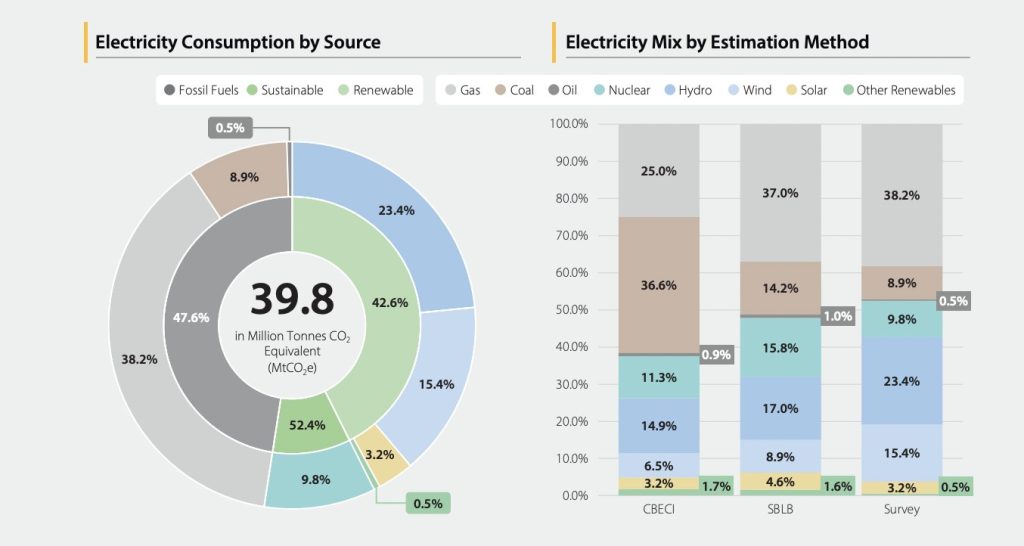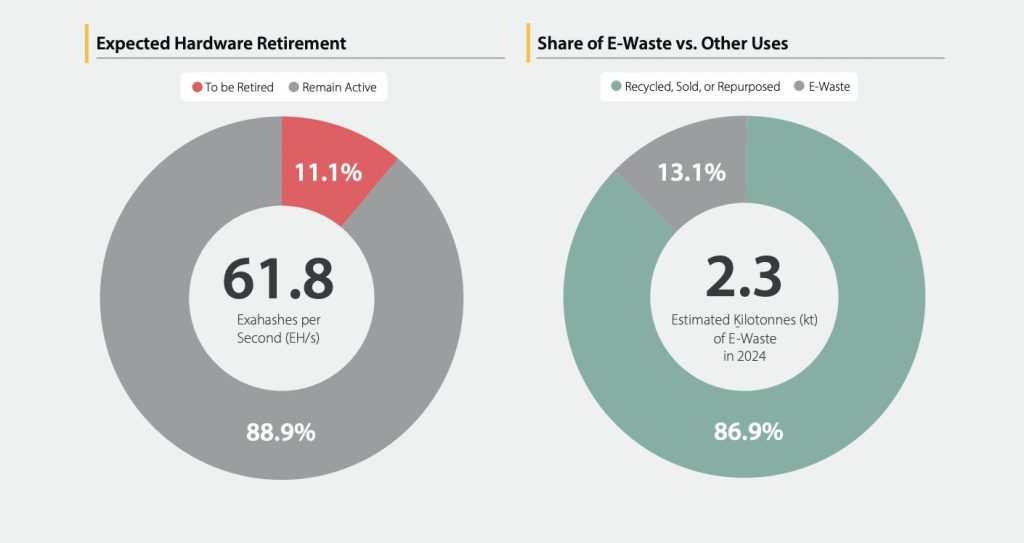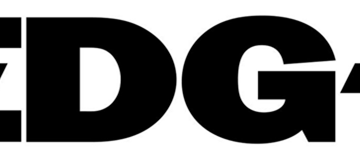Jeffrey Gogo
2025-05-15 06:59:00
cryptonews.com

Key Takeaways:
- New Cambridge University data shows that 52% of Bitcoin mining is now powered by renewable energy sources.
- Over the last three years, emissions from the industry have remained steady at 39.8MtCO2e.
- Mining hardware efficiency also improved, rising 24% year-on-year.
Researchers at Cambridge University recently released their latest report on Bitcoin mining, showing that over 52% of the network is now powered by renewable energy sources, up from 37% in their last report, in 2022.
It is a dramatic shift in the Bitcoin industry’s carbon footprint, which has long been criticized for damaging the climate.
The study by the Cambridge Centre for Alternative Finance (CCAF) shows that more miners are switching to cheaper, off-grid power. It says the 52.4% sustainable power used in BTC mining includes 9.8% nuclear and 42.6% renewables like hydro, solar, and wind.
For the first time, natural gas has replaced coal as the single largest energy source in Bitcoin mining – a process that involves solving complex mathematical puzzles to verify transactions and add them to the blockchain.
According to the report, natural gas, a cleaner burning fuel, now accounts for 38.2% of the electricity used to mine Bitcoin, up from 25% three years ago. Coal usage has dropped to 8.9% from 36.6% during the same period.
Bitcoin-Linked Greenhouse Gas Emissions Decline
For its study, the CCAF, which is based at the Cambridge Judge Business School, surveyed 49 Bitcoin mining firms from 23 countries. Some 41% of the companies are publicly listed, while the remainder are privately owned.
The companies surveyed include Bitfury, Hut8, Blockware, Mara, Riot, and Bitdeer. Together, they represent 48% of global mining activity.
CCAF used the data it collected from the firms to examine the operational intricacies of Bitcoin mining, market dynamics, and its environmental impact. Previously, it used publicly available data to estimate the ecological footprint of mining Bitcoin.
It found that Bitcoin is becoming greener, with more than 70% of the companies surveyed actively undertaking climate mitigation measures.
The report said Bitcoin-related emissions have remained steady over the last three years, stabilizing at 39.8MtCO2e (megatons of carbon dioxide equivalent), thanks to improved machine efficiency and a switch to renewable power.

The emissions come from an estimated network-wide annual electricity consumption of 138 TWh (terawatt-hours), or 0.5% of global electricity consumption. The figure represents an increase of 17% year-on-year.
When accounting for the impact of Bitcoin mining using cleaner power sources, such as flared gas – excess gas from industrial activity that would have gone to waste – net emissions drop to about 37.6 MtCO2e.
Climate tech investor Daniel Batten expected Bitcoin’s emissions to be 42 MtCO2e during the period under review. Analysts say the growing use of renewables could boost BTC’s adoption as a sustainable asset.
Tesla infamously dropped Bitcoin payments on environmental grounds in 2021. People on social media have wondered whether the electric vehicle maker will now reconsider its position in light of the Cambridge findings.
One promising area for mining is landfills, a major source of methane. A few firms have now started using power generated from landfill methane gas to mine Bitcoin. The gas is often vented directly into the air.
According to CCAF, mitigation from methane alone offsets 5.5% of total Bitcoin network emissions. Scientists say methane gas has a global warming potential over 20 years that is 80 times higher than that of carbon dioxide.
Improved Bitcoin Mining Hardware Efficiency
The report says the Bitcoin network’s emission intensity—the amount of carbon emissions it releases into the atmosphere per unit of power used—has dropped sharply since 2022, falling to 288.2 gCO2e per kilowatt-hour.

The figures dovetail with those from the Bitcoin Mining Council, which estimates that Bitcoin’s emission intensity has declined by around 50% during the four years to 2024.
It means that every time someone sends a transaction over the Bitcoin blockchain or uses the asset as a store of value, they are “net emission reducing”, Batten, who is also an environmentalist, previously told Cryptonews.
In addition, Bitcoin’s hash rate – or computational power used to mine and process transactions on a proof-of-work blockchain – has risen fourfold.

The researchers say BTC’s existing total emissions account for 0.08% of the global greenhouse gas emissions per year. For context, they say the figure is similar to the annual emissions of Slovakia and half that of the global tobacco industry.
However, critics have argued that any comparison should contextualize Bitcoin’s electricity consumption and environmental footprint with that of the industry it is directly disrupting – traditional finance, or TradFi.
TradFi relies on extensive physical infrastructure that uses vast amounts of electricity from burning fossil fuels. Meanwhile, BTC mining operations can relocate to regions with abundant renewable energy sources.
Estimates put the banking sector’s annual electricity usage at 4,981TWh. Critics also point to gold mining, which consumed 265TWh in 2023, nearly twice as much as the power used in Bitcoin mining, the digital equivalent of gold.
Apart from switching to sustainable energy sources, the Bitcoin mining industry’s efficiency is also improving.
As at the end of June 2024, the energy efficiency of mining hardware like application-specific integrated circuit (ASIC) miners was at 28.2 joules per terahash (J/TH), up 24% from a year ago, per the Cambridge report.
Miner hardware efficiency is expected to drop to 11.5 joules per terahash during this second quarter before falling further to 5.5 J/TH by the end of the year, it said.
Oleksandr Lutskevych, CEO of crypto exchange CEX.io, has told Cryptonews that the efficiency of ASIC miners improved by up to 1,000 times over the past decade.
Majority of Mining Equipment is Recyclable
The Cambridge University researchers said 87% of Bitcoin ASIC miners that were due to be phased out at the end of 2024 can be repurposed, recycled, or sold, with the actual e-waste approximated at about 2.3 kilotonnes.

This is “significantly lower” than the electronic waste generated in other competing industries, the study says. Of the Bitcoin mining companies surveyed, only 3.2% did not have a dedicated plan for e-waste.
ASICs are built specifically to mine Bitcoin more efficiently. They perform the calculations needed to verify transactions on the network a lot faster than graphics processing units (GPUs) or central processing units (CPUs).
Alexander Neumueller, research lead, digital assets energy, and climate impact at the CCAF, said:
“This report directly addresses a persistent data gap by relying on direct practitioner insights rather than abstractions. By offering a granular perspective based on data covering nearly half the global mining activity, we aim to anchor the debate on robust, transparent evidence and inform grounded policy discussions about this rapidly evolving industry.”
Bitcoin mining is concentrated in North America, with the U.S. accounting for 75.4% of total reported mining activity, followed by Canada at 7.1%.
Explore new destinations with ease using the Garmin Drive 52 GPS Navigator! With over 17,988 ratings and a solid 4.4/5-star rating, this GPS system has been a top choice for travelers. Over 500+ units were bought in the past month, all for only $144.99.
This 5″ GPS navigator comes with essential driver alerts, real-time travel data, and external memory storage. The simple on-screen menus and bright, easy-to-see maps make it easy to navigate wherever you are. Plus, it’s road trip-ready with The HISTORY Channel database, featuring notable historic sites and much more to enhance your journey.
Don’t miss out—get your hands on the Garmin Drive 52 today for a smoother ride ahead! Buy Now for $144.99 on Amazon!
Help Power Techcratic’s Future – Scan To Support
If Techcratic’s content and insights have helped you, consider giving back by supporting the platform with crypto. Every contribution makes a difference, whether it’s for high-quality content, server maintenance, or future updates. Techcratic is constantly evolving, and your support helps drive that progress.
As a solo operator who wears all the hats, creating content, managing the tech, and running the site, your support allows me to stay focused on delivering valuable resources. Your support keeps everything running smoothly and enables me to continue creating the content you love. I’m deeply grateful for your support, it truly means the world to me! Thank you!
|
BITCOIN
bc1qlszw7elx2qahjwvaryh0tkgg8y68enw30gpvge Scan the QR code with your crypto wallet app |
|
DOGECOIN
D64GwvvYQxFXYyan3oQCrmWfidf6T3JpBA Scan the QR code with your crypto wallet app |
|
ETHEREUM
0xe9BC980DF3d985730dA827996B43E4A62CCBAA7a Scan the QR code with your crypto wallet app |
Please read the Privacy and Security Disclaimer on how Techcratic handles your support.
Disclaimer: As an Amazon Associate, Techcratic may earn from qualifying purchases.





















































![TouchDesigner tutorial[RealseseCamera][Particle][InteractiveArt]](https://techcratic.com/wp-content/uploads/2025/08/1755986049_maxresdefault-360x180.jpg)























































